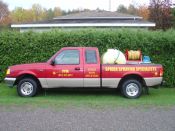
Carpenter Ants
Carpenter Ants can be found throughout Ontario. Carpenter ants are quite common destructive nuisance in Ontario and are normally about 6 to 22 millimeters in length. They are usually shiny, jet black in color with some variations of reddish brown. Carpenter ants are named for their habit of excavating, tunneling, living and nesting in wood.
Nests usually contain anywhere from 5,000 and up to 100,000 ants including satellite nests. Developmental time for workers takes at least 60 days. There is usually only one functional, wingless queen per colony.
Colonies usually mature in about 2 years; swarmers are usually not produced until after this period. In two to five years, a colony with a good supply of food may form a reproductive or dispersal generation. This generation consists of winged males and females. Males, known as drones, are about 16 mm long; winged females from 16mm to 22mm long. Most drones die shortly after fertilizing the female eggs. The females shed their wings immediately after mating and become full fledged queens. A 20mm long, wingless ant is probably a queen carpenter ant. The queen looks for wet, rotten wood in which to start new a colony or join an existing one. A queen starting a new colony lays about 30 eggs and cares for the larvae until they are adult workers. This new generation of workers takes over the various chores in the colony and the queen's full time job becomes laying eggs. These swarmers may appear from throughout the summer months and anytime of the year inside homes, cottages and buildings. The nearer a water and food supply is to the nest, the faster an ant population increases, and the greater the need to enlarge the galleries to accommodate the colony.
Carpenter ants will feed on honeydew, plant and fruit juices, insects, sweets, baking, meats, grease and kitchen crumbs. The workers forage for distances of up to 300 feet from the nest.
Because carpenter ants are nocturnal, their presence is usually only noticeable when a colony is under stress because of lack of water, food or nesting space, or because they are in a reproductive generation.
They do not eat wood, but remove quantities of it to expand their nest size, sometimes causing structural damage. Most carpenter ant species establish their first nest in decayed wood and later expand or enlarge this into sound wood. Inside, nests are located in wood preferably softened by fungus rot, in insulation, and/or in wall voids. The only external indication of infestation other than the presence of workers and/or swarmers is the appearance of small openings or sawdust on wood surfaces. Through these, the workers expel debris which consists of sawdust like shavings and fragments of insulation and insect body parts. The accumulation of such debris below such holes is a good indication of an infestation.
They typically enter buildings around door and window frames, eaves, plumbing and utility lines, and shrub and tree branches in contact with the building. Although some workers are active during the day, most activity is from dusk till dawn. Because carpenter ants are classified as wood destroying insects control can be difficult. The presence of a carpenter ant nest is sometimes indicated by a rustling sound coming from wall voids or from wood where the colony is located. Otherwise, the emergence of swarmers indoors may be the first indication of an indoor colony.
In a house or other building, infestations may begin because of a water leak around the chimney, roof valley, gutter, window, door frame or space under wooden floors where there is no basement. Sill areas invite ants, especially if soil touches the wood. Wood from new construction provides an excellent nesting place. Kitchen and bathrooms also often provide ample moisture for ant infestations through leaks in water pipes or water heating systems. The process of excavation by carpenter ants is what damages or weakens wooden structures. Tunneling can take place inside any piece of wood without visible signs of the process on the outside.
The presence of large ants usually is the first sign of infestation. Coarse sawdust is a sure sign, but it is often difficult to find the nest. Sometimes but not always the ants activity can be heard in walls and floors. Tapping areas suspected of harboring nests with a hammer may produce a hollow sound, and some excited ants may appear. Carpenter ants nesting habits can cause substantial structural damage to old or new homes alike.
There may be no need to tear walls open unless carpenter ants have damaged structural members such as timbers, studs, joists or sills. When the location of the nest cannot be determined or is inaccessible our commercial bait stations are often the best option. Our baiting stations allow foraging ants take the insecticide back to the nest and feed it to the queen(s) and other colony members. As a result, the entire colony often is destroyed.
Although carpenter ants do not sting, their bites can be quite painful, especially when they inject formic acid into the wound.
Please call us to book in for the 2025 ant control season or call us for a free, over the phone, ant control estimate.
- Phone (613) 966-4444
- Cellular (613) 813-3816
- Toll Free1-888-813-3816
** We also do Spiders, Flies, Wasps, Earwigs, Beetles, Box Elder Bugs, Asian Ladybugs, Sow Bugs, Pill Bugs, Bedbugs, Cockroaches, Fleas, Silverfish, Termites, All Other Insects, Wildlife, Bats, Rats, Mice and much more **
We are certified by the Ministry of The Environment and fully licensed and insured.
- Belleville
- Trenton
- Brighton
- Carrying Place
- Consecon
- Wellington
- Bloomfield
- Picton
- Ameliasburg
- Demorestville
- Frankford
- Stirling
- Tweed
- Madoc
- Bayside
- Foxboro
- Smithfield
- Wooler
- Cobourg
- Colborne
- Campbellford
- Kingston
- Deseronto
- Napanee
- Stone Mills
- Tamworth
- Inverary
- Quinte West
- Northumberland
- Prince Edward County
- Hastings
- Stirling Rawdom
- Trent Hills
- Thurlow
- Centre Hastings
- Camden East
- Frontenac
- Lennox and Addington
- City of Belleville
- City of Kingston
- City of Prince Edward County
- City of Quinte West
- Town of Cobourg
- Town of Napanee
- Town of Madoc
- Town of Brighton
- Town of Bancroft
- Town of Cobourg
- Town of Deseronto
- Town of Greater Napanee
- Town of Trenton
- Town of Frankford
- Township of Centre Hastings
- Township of Loyalist
- Township of Stone Mills
- Township of Addington Highlands
- Township of Madoc
- Township of Alnwick / Haldimand
- Township of Cramahe
- Township of Faraday
- Municipality of Brighton
- Municipality of Marmora
- Municipality of Trent Hills
- Municipality of Hastings Highlands
- Municipality of Marmora
- Municipality of Tweed
- County of Hastings
- County of Northumberland
- County of Lennox and Addington
- City of Belleville
- City of Kingston
- City of Prince Edward County
- City of Quinte West

